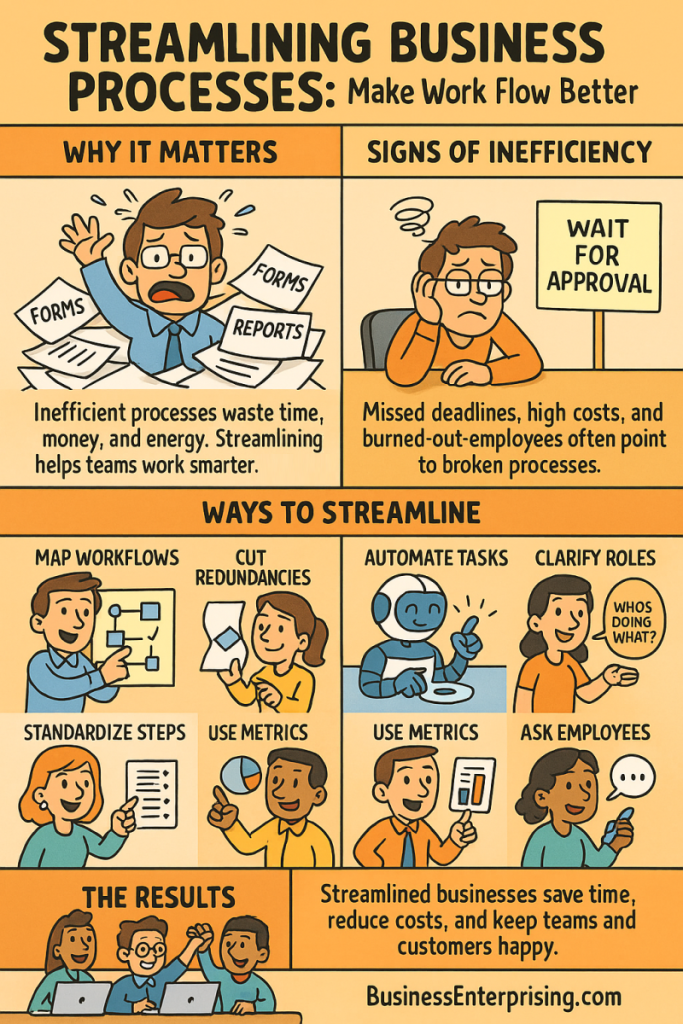
The Impact of Inefficient Business Processes
Inefficient business processes slow down progress and waste resources. When tasks take longer than necessary, costs rise and productivity drops. Errors increase, deadlines get missed, and customer satisfaction can suffer. These issues stack up over time and affect overall performance.
Additionally, inefficient systems often lead to employee frustration. People spend more time fixing problems than doing meaningful work. As a result, motivation declines and turnover may increase. You might notice missed opportunities simply because your systems don’t respond fast enough.
Therefore, reviewing and improving workflows should be a priority. Even small delays in communication or approval steps can create bottlenecks. These delays not only waste time but also increase the chance of mistakes. Streamlining business processes helps you avoid those risks and keeps things moving forward.
You may also find that inefficiencies prevent growth. As your business scales, problems grow with it. What once worked for five employees may break down with fifty. Regular reviews help identify gaps before they become bigger problems. Additionally, technology can often support better workflows.
When processes are slow or unclear, customer experiences suffer too. Delays in service or fulfillment can push clients away. Therefore, a clear and simple process benefits everyone involved. From staff to customers, smoother operations lead to better outcomes.
Inefficient business processes are a significant concern for many business owners. These inefficiencies can manifest in various ways, including redundant tasks, bottlenecks, and also miscommunications. When businesses do not streamline processes, they encounter numerous problems, such as:
Reduced Productivity:
Inefficient processes often force employees to spend extra time on tasks they could automate or streamline. This lost productivity directly hurts the bottom line.
Increased Costs:
Wasting time increases operational costs. When teams take longer to complete simple tasks, the business uses more resources than necessary.
Employee Frustration:
Inefficient processes frustrate employees and reduce their job satisfaction. When they work with broken systems, they often feel discouraged and disengaged. This frustration can lead them to leave, which increases turnover and worsens inefficiency.
Customer Dissatisfaction:
Inefficiencies cause delays and mistakes that frustrate customers. When you fail to meet expectations, you risk losing their trust in a competitive market.
Identifying Inefficiencies in Business Processes
Identifying inefficiencies starts with knowing where time and resources get lost. You might notice repeated tasks or delays between steps. These small issues often point to bigger process problems. Therefore, tracking workflows helps highlight what slows things down.
Additionally, pay attention to employee feedback. People doing the work each day see what doesn’t run smoothly. Their input often reveals gaps, extra steps, or outdated tools. You can learn a lot just by asking the right questions. However, you also need to observe where breakdowns happen in real time.
Look for tasks that require manual work or too much approval. These steps often delay progress without adding value. Therefore, review each part of your process and ask if it’s still needed. Just because something’s always been done a certain way doesn’t mean it still makes sense.
Also, missed deadlines or frequent rework can signal deeper inefficiencies. Maybe roles are unclear or tools don’t connect well. Additionally, duplication across departments often means your systems aren’t aligned. These issues waste both time and money over the long run.
Streamlining business processes depends on identifying what doesn’t work. Once you know the problem, you can start testing better options. Data helps confirm where things stall, but day-to-day experiences matter just as much. Therefore, take a close look at how tasks move across your teams.
Before streamlining business processes, it’s important to first identify where these issues lie. This process involves a thorough analysis of current operations. Key steps include:
Mapping Out Processes:
Creating detailed flowcharts of existing processes can help visualize where inefficiencies occur. This method allows for a clear understanding of each step involved in a process and identifies redundant or unnecessary tasks.
Gathering Feedback:
Employees are often the best source of information about inefficiencies. Conducting surveys or holding meetings to gather their insights can reveal valuable information about where improvements are needed.
Analyzing Data:
Data analytics can provide insights into where time and resources are being wasted. Metrics such as cycle time, error rates, and resource utilization can highlight areas of concern.
Benchmarking:
Comparing processes against industry standards or competitors can help identify areas where a business may be lagging.
Strategies for Improving Operational Efficiency
Improving operational efficiency starts with simplifying how work gets done. When tasks are clear and tools work well, teams move faster. Therefore, review current workflows to see where delays or confusion happen. Often, small process changes can create big improvements.
Additionally, automate repetitive tasks wherever possible. Manual work wastes time and increases the chance of errors. Using software for scheduling, billing, or communication frees up your team. However, automation only works when your processes are already clear. Fix broken steps before adding new tools.
Training also plays a big role in efficiency. When people understand their roles, they make fewer mistakes. Therefore, invest time in teaching your team how to use systems and follow procedures. Consistent training helps prevent slowdowns and confusion across departments.
Another strategy involves improving team communication. When everyone knows what to expect, projects run smoother. Additionally, regular check-ins help you catch problems early. Clear roles and shared goals reduce duplication and missed tasks.
Streamlining business processes is one of the most effective ways to improve operational efficiency. Remove unnecessary steps and connect related tasks. That kind of structure keeps work flowing without roadblocks. Additionally, use performance metrics to track what’s working and what’s not.
Once inefficiencies are identified, the next step is implementing strategies to improve operational efficiency. Several approaches can be employed:
Automation:
One of the most effective ways to improve efficiency is through automation. Automating repetitive as well as time-consuming tasks can free up employees to focus on more strategic activities.
Process Reengineering:
Sometimes, processes need to be completely redesigned rather than just tweaked. Business Process Reengineering (BPR) involves a radical rethinking of processes to achieve significant improvements in performance.
Training and Development:
Ensuring that employees are well-trained and equipped with the necessary skills is also crucial. Regular training sessions and workshops can also help employees stay updated on best practices as well as new technologies.
Lean Methodology:
Lean principles focus on minimizing waste and maximizing value. Adopting lean methodologies can help streamline processes and improve overall efficiency.
Continuous Improvement:
Efficiency is not a one-time achievement but an ongoing process. Implementing a culture of continuous improvement ensures that processes are regularly reviewed and refined.
Recommended Books and Online Courses
Learning more about streamlining business processes can help you make better decisions and avoid costly mistakes. Books and online courses offer flexible ways to gain skills and insights. They’re especially useful when you’re trying to solve real problems in your business.
Additionally, reading allows you to explore proven methods used by other companies. Many books focus on case studies, tools, and frameworks that you can apply right away. However, not every book fits every situation. Therefore, focus on those that match your industry or goals. Choose materials that speak directly to the challenges you face.
Online courses are a practical option if you want more structure. They often include step-by-step instructions, templates, and assignments. Therefore, you get hands-on experience with concepts that matter. Additionally, some courses let you move at your own pace, which helps when schedules are tight.
Look for content that focuses on solving specific pain points. Whether it’s workflow design, project management, or automation, each subject connects to efficiency. Streamlining business processes takes more than guesswork. It requires thoughtful learning and testing ideas that work for your team.
For business owners looking to enhance their operational efficiency, online courses, books and consultants can also be invaluable resources. They offer in-depth knowledge and practical tools for improving business processes. Here are some recommendations:
Online Course:
Business Operations – Optimize your business operations and boost efficiency with this comprehensive course designed for business owners seeking practical strategies and tools for streamlined operational protocol.
Book:
Complete Guide on How to Operate a Business More Effectively – Unlock the secrets to running a more efficient business with this essential guide, offering proven strategies and practical insights for streamlining operations and maximizing productivity.
Consultants:
Small Business Consulting – For more personalized assistance, consider expert consultants who specialize in helping business owners enhance operational efficiency through tailored strategies and actionable insights for optimal performance and growth.
Conclusion
In conclusion, many business owners struggle with inefficient processes, but they can overcome these challenges. When you identify inefficiencies and apply strategies to improve operational efficiency, you boost productivity, cut costs, and increase customer satisfaction. Online courses and books offer the knowledge and tools you need to reach these goals. When you invest in improving your processes, you strengthen your position in a competitive and ever-changing market.
Streamlining business processes takes consistent effort and focus, but you gain significant rewards in return. When you commit to continuous improvement and stay informed through educational resources, you turn inefficiencies into opportunities for growth and success.


